Science & Technology _|_ Issue 17, 2020
EntaNgled Life
Dr Merlin Sheldrake talks about the remarkable world of fungi and what they can tell us about ourselves


Entangled Life
Merlin Sheldrake talks about the remarkable world of fungi, and considers what they can tell us about ourselves
Merlin Sheldrake’s book ‘Entangled Life’ [1] has rather taken the world by storm since it was published in 2020, appearing on the best-seller lists in both the UK and USA. Subtitled ‘How Fungi Make Our Worlds, Change Our Minds and Shape Our Futures’, it constitutes a comprehensive overview of our current scientific understanding of fungi, from the extraordinary hidden networks of the ‘wood wide web’ to their potential to solve our problems of waste disposal. Merlin describes himself as a biologist (he has a PhD from Cambridge University), a musician and ‘keen fermenter’. He spoke to Carolyn Markson and John Brown about why this hitherto invisible world of interconnected life is revealing itself to us now.
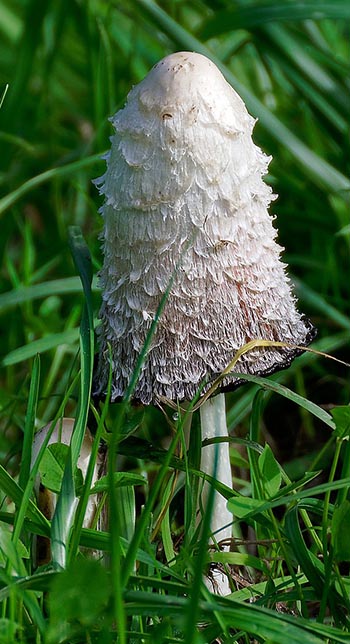 Until recently, fungi have been a relatively neglected area of study, but as Merlin Sheldrake’s recent book, Entangled Life, [1] reveals, the fungal world is as vast, varied and complex as the realms of plants and animals which have been the object of human investigation since antiquity. Combining the latest scientific research – the field is called ‘mycology’ – with stories of personal experience and a vivid style of writing, Entangled Life is an accessible and comprehesive introduction to a subject which seems to have particular relevance to us today. Isabella Tree – of Wilding fame [2] – has said that it ‘changes the way we need to look at life, the planet and ourselves’ and it does, indeed, seem that almost every page reveals some new, hitherto unsuspected wonder.
Until recently, fungi have been a relatively neglected area of study, but as Merlin Sheldrake’s recent book, Entangled Life, [1] reveals, the fungal world is as vast, varied and complex as the realms of plants and animals which have been the object of human investigation since antiquity. Combining the latest scientific research – the field is called ‘mycology’ – with stories of personal experience and a vivid style of writing, Entangled Life is an accessible and comprehesive introduction to a subject which seems to have particular relevance to us today. Isabella Tree – of Wilding fame [2] – has said that it ‘changes the way we need to look at life, the planet and ourselves’ and it does, indeed, seem that almost every page reveals some new, hitherto unsuspected wonder.
Fungi do not fit in to our traditional classification of things as animal, vegetable or mineral. They lie somewhere between plants and animals, and as Merlin points out, there is no university department devoted specifically to them. Before the burgeoning interest of the last few decades, many aspects of fungal life were largely invisible and their properties unknown; of the estimated 2.2 to 3.8 million species, 90 per cent are still undocumented. We began by asking him what he thinks has brought them into view now.
“I think there are a number of reasons, some of them quite simple. One is that we now have technologies that we simply did not have a few decades ago, like DNA sequencing, which enables us to take a pinch of soil and work out all the organisms that are present in it. So increased access to microbial and fungal lives allows us to ask more questions and satisfy our curiosity about them in new ways. We see a similar explosion of interest in other types of microbe, like bacteria, for the same reasons.
“There are other factors. Fungi live their lives as networks – known as mycelium. In recent decades network thinking has risen to prominence within many disciplines of human study. This has been driven in part by the Internet and the digital networks that we are now all familiar with, but network models are also now used, for example, in biology, where parts of cells are understood to be strung together in networks of interaction.
“Yet another reason is that there has been lots of work on the properties of the psychedelic compound psilocybin, produced by a number of species of ‘magic’ mushrooms. Psilocybin has shown great promise in treating conditions ranging from depression to addiction. There is a huge amount of research into the subject going on now, and it has already led to psilocybin mushrooms being decriminalised in several US states.”

Hunting for white truffles in Piedmont, Italy, where dogs are used to locate the hidden delicacies by their strong odour. Truffles are the most sought-after edible mushroom, one kilo fetching about 6,000 euros. Photograph: Dario Fusaro/Alamy stock photo
Hidden Networks
.
When most of us think of fungi we think of mushrooms, but these are only the fruits of the much larger mycelium which are hidden from view. These sprawling web-like structures can be huge: one honey fungus in Oregon spreads over ten kilometres, weighs hundreds of tons, and is estimated to be between 2,000 and 8,000 years old. And they are ubiquitous: the mycelium in a teaspoon of soil, Merlin tells us in the book, would stretch from one to ten metres if they were teased out. It seems amazing, we comment, that we have been living in such intimate contact with these life forms all the time, and yet we have been almost completely unaware that they are there.
“The question of visibility was a big challenge in writing the book. Fungi have long been known to us as things like mushrooms, or in the form of alcoholic drinks or bread. But when we are talking about mycelium living in the soil, our senses can only take us so far. So I had to think carefully about how to write about them in a way that would allow people to relate to them. I had to use metaphors and stories to make them more accessible and to engage people’s imaginations.”
The most obvious metaphor, as we have already mentioned, is that of the Internet. Does he think that this paved the way for this new understanding? Merlin thinks it is not so simple. “The understanding of biological networks and computer networks have really developed in parallel, rather than one leading to another. It was in the late 1990s that the term ‘the wood wide web’ was coined, just at the time when the Internet was coming into being and the World Wide Web was being mapped. But much of the early research was going on in the ’80s. Without doubt, though, ‘network thinking’ has made it possible to conceive of this kind of system, where resources are distributed and shared.”
But there are many other images and metaphors which Merlin employs. In describing how the multiple growing tips of a fungus (called hyphae) act – at one level, in a seemingly independent way but at another the whole body acts as a single entity – he makes an analogy with swarms of insects or schools of fish. In these, the members act as a collective even though, as in fungi, there is no central command centre. However, he points out that mycelium quickly outgrow the swarm analogy. “Because all the hyphal tips in a network are connected to one another… one cannot dismantle a mycelial network hypha by hypha once it is grown as we could pick apart a swarm of termites.” [3] Fungi therefore exhibit an even higher – and more mysterious – degree of interconnectivity than we see in the animal world.
In other places, he uses physiological imagery. Referring to the use of layered diagrams to describe the structure of the body in textbooks – one layer for organs, one for bones, one for the nervous system, etc. – he imagines that if we were to draw the same sort of diagram for the earth’s biological systems, the vast networks of mycelium would have a whole layer to themselves. He calls them ‘ecological connective tissue’, and ‘the living seam by which much of the world is stitched into relation’.[4]
But he is also aware that these metaphors can restrict our understanding of what is, in the end, a life form which is very different from anything else we know. “We lose something when we use the analogy with, say, digital networks to understand mycelium, because actually they are not made up of cables and routers; they are living organisms. So when we talk about the ‘wood wide web’ there is a danger of mechanising it.”
Unusually perhaps for a scientist, Merlin is not only interested in what we can learn about fungi. He also wants to think about what they can teach us: “We tend to make analogies using human ideas, human systems, which we project onto ecosystems. But we don’t have to do this. Instead, we could try to think ‘outside the skull’ and let the ecosystems themselves become metaphors for human life. We could allow them to be what they are, and let them populate our imaginations with useful analogies of how to make sense of ourselves.”
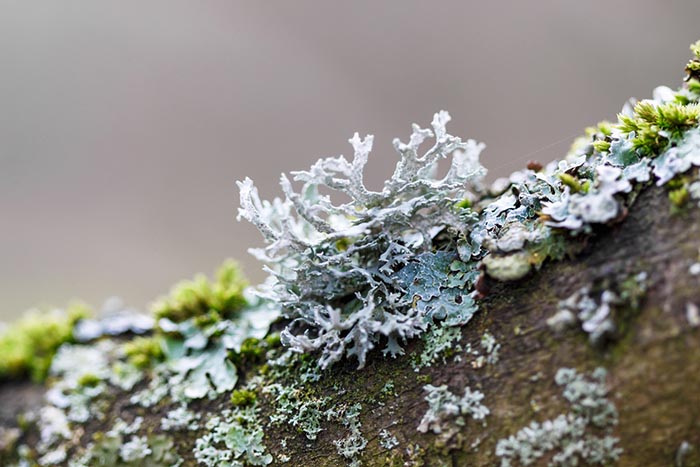
Lichen; what we call ‘lichen’ are actually a symbiotic collaboration between algae and fungi. Photograph: mgfoto/iStock
Interconnectedness
.
The term ‘wood wide web’ refers to the discovery in the ’80s of the extensive symbiotic relationship between trees and fungi in forests. ‘Symbiotic’ means literally ‘living together’, and biologically, refers to a collaboration between different species which is mutually beneficial. The fungi enable individual trees to draw nutrients and resources from the soil and to share them with other trees, in a sense communicating with them. In return, the trees provide fungi with the nutrition and resources they need to thrive (for more, see video right or below).
Video: The Wood-wide Web. Duration: 2:30
More recently, it has been shown that cooperative behaviour by fungi is not limited to trees; they seem to have an incorrigible desire to form long-term collaborative partnerships both with each other and other species. Some of these relationships are so embedded that we have come to regard the resulting entity as a separate species – lichen, for instance, or seaweed. But until we read Entangled Life, we were not aware that what we call plants in general – all plants – actually evolved out of a collaboration between algae and fungi. Current evolutionary theory maintains that plants would not exist at all if, at an early stage of evolution, green algae moving from water onto land had not teamed up with fungi which provided them with the equivalent of roots, allowing them to access nutrients in the earth. As millennia have passed, plants have developed their own root systems, but nevertheless, about 90 per cent of them still depend to some degree on their fungal partners. The two species are inextricably enmeshed and entangled underground in what are called ‘mycorrhizal relationships’.
This degree of cooperation means that it is hard to say where one species begins and the other ends, challenging the idea that the world is made up of individual beings that operate independently. Merlin agrees: “We really like stories where we are isolated individuals who can go about our lives doing as we wish. It is this type of individualist narrative that helps to justify the environmental destruction and degradation that we are wreaking on the planet: if we really understood that everything is interconnected, we would see that by destroying the ecosystems that sustain us we are ultimately harming ourselves, and that it is irrational and unjustifiable. And of course, it is irrational and unjustifiable but we live within powerful narratives about independence and autonomy which help us forget this.”
It also rather changes our understanding of the way things develop and grow. When we consider the relationship between plants and fungi, did fungi help plants to evolve or is it the other way round? Merlin thinks that it is probably both. “If you look at 400 million year old fossilised roots you can see fungi living inside them and they look just like the ones that we see today. Plants, on the other hand, have changed quite a lot over this time.
“Of course, there have also been huge innovations in the fungal world – the appearance of mushrooms, for instance, to help the spread of spores – but the basic mycelial lifestyle seems to have existed for a very long time and there is not much that can be improved on. You could perhaps say that fungi hit the jackpot early on.
“But actually, we cannot really answer a question like this. It is a perfect example of the way that symbiosis forces us to think not in terms of individuals but of relationships. What we call plants are algae that have evolved into plants alongside fungi, so everything we see in the plant world is the outcome of an association. It is all a two-way process.”
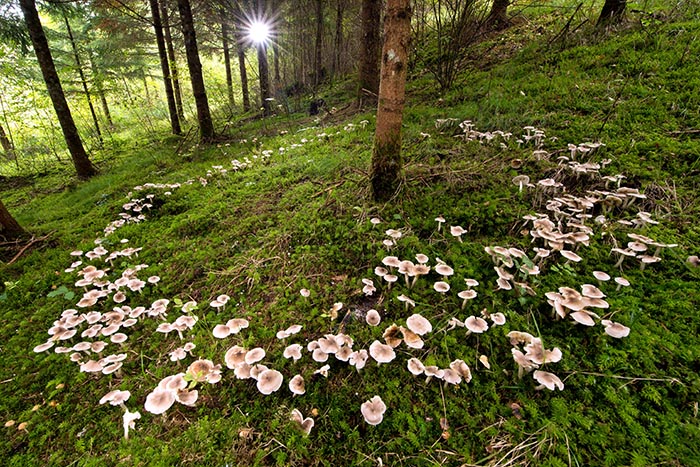
The wood wide web. The mushrooms are just the visible fruits of the vast underground networks of mycelium which form a symbiotic relationship with the tree roots, enabling both partners to thrive. Photograph: BIOSPHOTO [/] / Alamy Stock Photo
Immersion in the World
.
Symbiosis also makes us think in non-hierarchical ways. In the book, Merlin points out that when thinking of the wood wide web, for instance, we tend to consider primarily the benefit to trees as the ‘higher’ – and therefore, we assume, dominant – organism, but certain phenomena can only be explained when we understand that this is a true partnership in which conditions are also optimised for the fungi.
Our tendency to see hierarchies is most manifest when we think of ourselves as the pinnacle of evolution, the top of the pyramid. But Merlin would like to change this perspective. “I think it is interesting for us to pose questions like: where are we looking at the world from? Where are we positioning ourselves? I think we can do a lot of work to de-centre our privileged human placement by doing little things like asking: who is domesticating whom? If we keep asking this question, then the power – I should perhaps say, the assumed power – of the human becomes diluted. I think these lines of enquiry can bring us into a more honest and less destructive relationship with the living world.”
Thinking about our relationship with the world, it is noticeable that Merlin himself is a very hands-on sort of scientist, and immersion – often literally – in his subject matter is one of the striking features of his research as documented in Entangled Life. Chapter 7, for instance, begins with words: “I lay naked in a mound of decomposing wood chips and was buried up to my neck by the spadeful” – describing his sampling of a Japanese fermentation bath in California.[5] Is this a form of science that he thinks should be encouraged?
“Well I think it depends on what kind of person you are. This is really just a method that I like; I am interested in the way things work and can explore them more readily if I am in direct contact with my subjects. It opens up new pathways of enquiry for me. This is why I wanted to do the things with the book, such as growing mushrooms in it and then eating them, as this was a way of folding me and the book back into the world. I had spent so much time talking about the world and felt I had not been in it enough. I would not want to be evangelical about this approach, but I find it fun and it keeps me healthy.” (To see Merlin eating his book, see video right or below.)
Video: Merlin eating his book. Duration: 2:24

Japanese fermentation bath. Photograph: Osmosis Spa Centre [/]
The Living Foundation of Life
.
Fungi have not just been pivotal to the evolution of life in the past: they continue to be central to its maintenance in the present. Could we say that they are the underpinning of the whole organic world? “Yes, you could say that, but the same is true for bacteria. In evolutionary terms, multi-cellular organisms and the whole hierarchy of the higher plants and animals are relatively recent. These microbes create the conditions for life, and continue to do so. You can think of them as a kind of living foundation.”
This understanding has enormous, important implications for the way that we understand the ecology of the planet. For plants to flourish, they need a good supply of nutrients and this requires them to form healthy relationships with mycorrhizal fungi in the soil. Therefore the fungi also need conditions in which they can flourish. All this adds up to the health of soil being of paramount importance. As Merlin explains: “Ever since human beings have started farming, around Neolithic times, the most important thing that we have had is the fertility of the soil. We have needed to think about what we put into the soil and how we are maintaining its fertility, because it is our bank – our capital – that produces the food that sustains us every year.
“When you think properly about the soil, and begin to see it as a living collective, then you can see that fungi play a lot of different roles in maintaining it. But the first step is to realise that we need to add carbon back into the soil – often in the form of vegetal mass. This might look like growing a crop and ploughing it back into the earth or by letting animals trample plant matter into the ground so that bulk is added to the soil, rather than it being reduced to a kind of mineral powder. When you harvest without putting mass back into the soil, then you are basically mining – mining the carbon, just as we remove coal from the earth.
“But if you put the carbon back, then you create conditions where these microbes can go about their lives. Then they will re-establish the mycelium webs by means of which the complex ecological and dynamical processes which characterise a healthy system can flourish.”
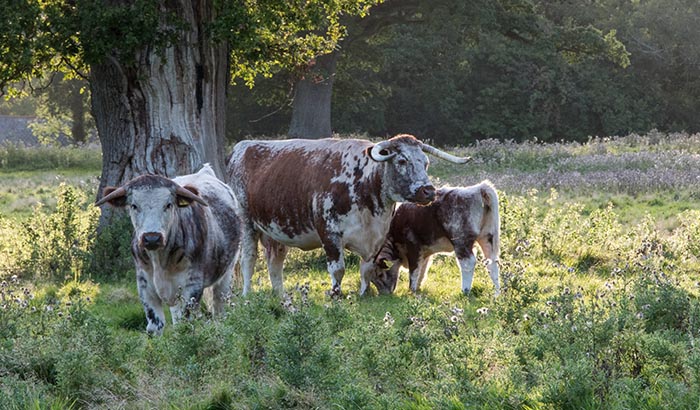
Longhorn cattle at the Knepp Estate, Sussex, which has pioneered the idea of ‘wilding’ in the UK. (Click here for more). ‘Naturalistic grazing’ allows plant material and manure to be returned to the earth, increasing both fertility and biodiversity. Photograph: Charlie Burrell/Knepp Estate
The problem with most of our current farming methods – and our forestry – is that not only do they not replenish the soil, but they also break it up so that the mycelium cannot do their work. As Merlin explains: “Modern industrial agriculture has developed without considering the life of the soil at all. More than this, one could say that it has developed without considering the life of humans who depend upon it. It is a massive, industrial corporate project which has its priorities in the wrong places, and it is leading us into a disastrous situation.”
So, is it hoped that this new knowledge about the interconnectedness of plants and fungi will lead to a change? “Yes, indeed. This is already happening in grassroots sustainable agriculture circles, where people have been thinking a lot about soil, and how fungi and microbes can not only be maintained in it, but also used to improve and nurture it. For instance, some people are working with old agricultural systems like the Korean system where they use compost ‘teas’ – liquid fertilisers – that you add to your plants and which also help the microbes within the soil.”
He goes on: “But I think that these ideas will also have an effect upon people within conventional agricultural circles as it becomes clear that our present unsustainable methods are going to have an impact within a very short time frame – in fact it is already happening; this is not in some distant future. I think that farmers will watch their soil turn to dust and blow away, and then it will be clear what the effect has been of all these chemical fertilisers produced by the big agri companies, and that our present system cannot go on without causing total disaster. So the movement for change is picking up speed for sure – let’s just hope that it is not too late!”
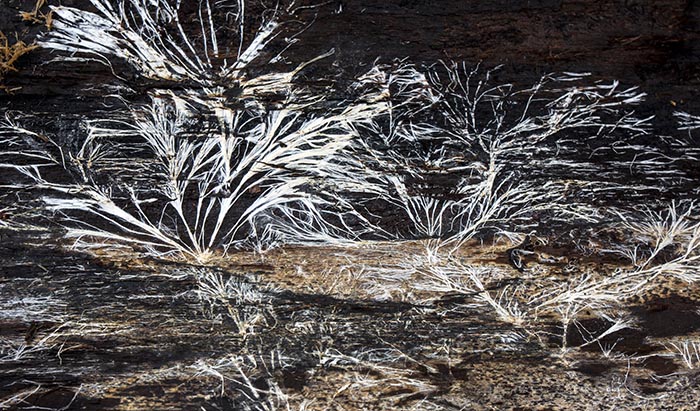
Patterns formed by mycelium fungus on the inside of tree bark. The ability of fungi to break down wood was an important evolutionary step; in the early Carboniferous period, wood went unrotted and has been preserved as coal. Photograph: Michael Cornelius/123rf Stock Image
Decomposition and Remediation
.
This brings us to another pivotal role that fungi play in the ecosystem: they are the principal agents of decomposition. This is another area where Merlin feels that their value has been overlooked. “The matter of decay is something very interesting for human beings to think about now. There is a great story I read in a book called Farmers of Forty Centuries by F.H. King, which is about Chinese rural life in the 19th century.[6] King describes how all the farmers had toilets along the roadside and how they were all desperately competing for travellers to come and use theirs because then they could use the waste to compost their fields. The story highlights how different our relationship with these things is now, and how dysfunctional it is. In our Western culture, we spend huge amounts of money processing sewage as a kind of pollutant rather than working with it.”
But the value of thinking about decomposition, he feels, goes beyond simple practicality: “Decomposition is a fundamental part of life, and one to which we don’t really give enough attention. Fungi are real masters of this, and so thinking about them changes our understanding of what it means to live in the world. When you walk in a forest, what you see around you is the space that is left behind by the process of decomposition. And of course, we are doing the same all the time within our own bodies, constantly replacing skin and other organs in a process of controlled cell death.”
One of the most fascinating chapters in Entangled Life is entitled ‘Radical Mycology’ where Merlin explores leading-edge research – mostly happening at a grassroots level – into what is called ‘mycoremediation’, meaning the use of fungi to dispose of waste that, at the moment, we are unable to recycle. Plastics, for instance: might fungi help us to remove plastic pollution from the oceans?
Merlin is cautiously hopeful: “Well, first of all, it is important to realise that there are some plastics which fungi cannot deal with, and some that they can. But for this to happen on any kind of scale, we have to concentrate the plastic in one place, and then expose it to organisms which can digest it and degrade it – not just fungi but also bacteria. And this is not much good for removing plastics from the sea, where it is quite dispersed.
“Also, fungi can only transform stuff from one form to another and so we have to think about what we will do with the by-product. This means that we have to take an ecological view. When we produce vegetable compost, there are various skilful processes and methods that have to be applied until we get to something that we can actually use. So if we think about mycoremediation as being very advanced experimental composting, we get close to seeing what might be involved; we have to think about what strains of fungi we will use and how to create the best conditions for them to grow; how they will need help from various bacterial strains, and so on. We have to build a system.”
So, is it a feasible proposition? “It is not impossible to do, and there is a lot of room for advanced research. I just wish that there was more money being put into it. At the moment the remediation industry is quite dysfunctional, I feel. We really need to reimagine our whole philosophy of waste, because we don’t look at the whole life cycle of the things that we produce. We kind of throw them into the environment and then think about how to dispose of them later. For instance, there is some research now into using fungi to dispose of asphalt roofing. Asphalt makes up a huge proportion of our landfill waste, and it would clearly be better to intercept this before it enters the environment. Some fungi are well adapted to the task of breaking it down and can produce a by-product which can either be used for something else or disposed of in another way.
“This is ultimately what needs to happen. But obviously at the moment we are not in this position and we need the help of fungi to deal with pollutants that have already been released into the environment. An example is the wild fires in California, where toxic ash from the materials used in buildings runs off into the soil and water ways. But it has been discovered that certain fungi can decompose or bind to these chemicals, so now there are grassroots activists experimenting with what they call ‘wattles’ – big, sausage-like bags – full of mycelium and straw which they place around the sites, so that when the ash hits them it is decomposed or concentrated.” (Click here for more [/].)
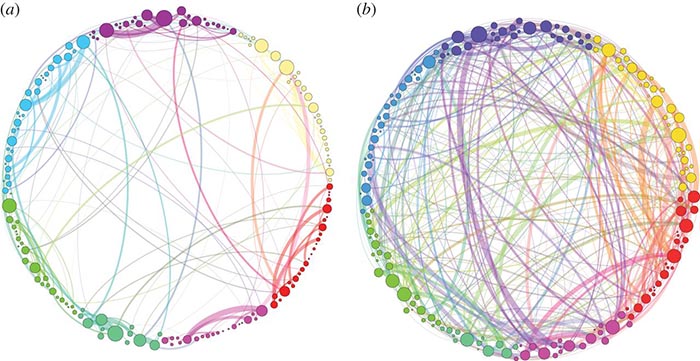
Interconnections between networks of brain activity during normal waking consciousness (a) and after the injection of psilocybin (b), showing the way that a tumult of neuronal pathways are stimulated. Image: from Petri et al (2014) [7]
Transformation and Consciousness
.
The ability to break down waste products is really just a subset of fungi’s general power to affect transformation. We are all familiar with the activity of yeast (a single-cellular form of fungus) in producing bread and alcohol, and the ability of the latter, in turn, to transform our own mental states when we are intoxicated. Merlin devotes a whole chapter of Entangled Life to the mind-altering power of psychedelic drugs derived from fungi such as psilocybin, and the discovery of their potential healing power for a wide range of mental conditions. In an engaging section, he describes his own participation in an LSD trial and his attempt to answer the closing questionnaire: “On a scale of one to five, how would you rate your loss of your usual identity? How would you rate your experience of pure Being?” [8] But in a short interview, we do not have time to explore all these fascinating avenues.
Nor do we have the space to explore the other ways in which fungi have the ability to heal us – in the development of anti-biotics, for instance – or the non-beneficial/unhealthy aspects of fungal relationships, such as the ‘zombie fungi’ which can control the behaviour of their victims, or the rice blast fungi which destroys enough rice every year to feed six million people. Instead, we turn our attention in our final question to metaphysical matters: what about consciousness? Recent research reveals that fungi are extremely good at solving problems and overcoming obstacles, exhibiting the kind of creative, intelligent behaviour we might expect to find only in organisms higher up the evolutionary scale. Slime moulds, for instance, are so efficient at finding the most direct route between two points that people are now trying to turn them into computers – a new sort of organic computer capable of solving problems that are still hard for minerals. At what point do we start to attribute consciousness to an organism?
Merlin is a bit wary of the question: “Consciousness is a very tricky issue to talk about scientifically, because science is really about studying things from the outside using empirical methods, whereas consciousness is inherently subjective. So empirical methods really don’t have access to the rich, subjective worlds that we all know and are so familiar with from the inside. It is very hard to prove that another human being is conscious from the perspective of the natural sciences, so how could you prove that a fungus is?
“So when talking about consciousness, we start to move out of the comfort zone of the empirical sciences. My own views, for what they are worth, tend towards panpsychism – the idea that consciousness could be a fundamental feature of the universe. (For our article on ‘Panpsychism and the Problem of Consciousness’, click here) There are many different versions of panpsychism, but I have personally found the views of Alfred North Whitehead [/] very helpful. Whitehead sees the most fundamental unit of existence as drops of experience – what he calls ‘an occasion of experience’. And over the period of evolutionary history, he thinks that human beings have evolved to be very complex amplifiers of experience.
“And so I think it is fun to consider that the same might be true of mycelium – that they, too, have evolved to be complex amplifiers of experience. And because they are very different sorts of amplifiers, the resulting experience that arises is also very different. But I really don’t know how to imagine what that might be like!”
So what happens next, now that the book is finished? “I’d like to do more work on electrical signalling in fungal networks – the way they use electric impulses to coordinate their activity. I think this is a really exciting field of research. I am also interested in fungal conservation initiatives – projects which are working towards putting fungi on the map, so to speak – I mean the conservation map. The fungal world is so vast and there is so much more to explore.”
Cartoon by Simon Blackwood
Image Sources (click to close)
Banner: Merlin with his book propagated with edible mushrooms. Photograph: Merlin Sheldrake.
First inset: Shaggy ink cap (Coprinus comatus). When fresh, this is an edible mushroom, but within days it turns black and liquefies, so that it can be used as ink. All the line illustrations in Entangled Life were drawn using this ink. Photograph: Jakub Halun via Wikimedia Commons.
Other Sources (click to open)
[1] MERLIN SHELDRAKE, Entangled Life (The Bodley Head, London, 2020).
[2] ISABELLA TREE, Wilding (Picador, 2019).
[3] Entangled Life, p.53.
[4] Entangled Life, p.52.
[5] Entangled Life, p.195.
[6] F.H. KING, Farmers of Forty Centuries (CreateSpace Independent Publishing Platform, 2016).
[7] Petri et al ‘Homological scaffolds of brain functional networks’ in Journal of the Royal Society Interface, 11 (2014), 20140873.
[8] Entangled Life, p.105.
FOLLOW AND LIKE US
——————————————
——————————————
——————————————
Video: The Wood-wide Web. Duration: 2:30
Video: Merlin eating his book. Duration: 2:24
FOLLOW AND LIKE US
If you enjoyed reading this article
Please leave a comment below.
Please also consider making a donation to support the work of Beshara Magazine. The magazine relies entirely on voluntary support. Donations received through this website go towards editorial expenses, eg. image rights, travel expenses, and website maintenance and development costs.
READ MORE IN BESHARA MAGAZINE
Rewilding: A Hope for the Future
In the light of the recent UN report on the radical decline of biodiversity, Richard Twinch investigates a movement which promises to restore ecological harmony
Panpsychism and the Problem of Consciousness
Richard Gault explores a revolution in scientific and philosophical thought
Sheldrake: Memory, Habits and Wholeness
Biologist Rupert Sheldrake challenges the dogmas of conventional science, and explains how recent research supports his alternative theory of morphic resonance
A Biology of Wonder
An interview with scientist Andreas Weber, whose radical ideas are transforming our understanding of nature
READERS’ COMMENTS

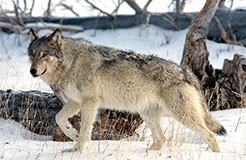
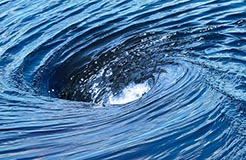

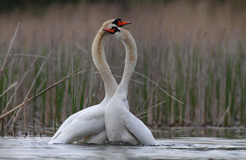
Recently attended the ORFCGlobal conference where Merlin was a presenter – such an erudite and entertaining session. Mr. Sheldrake’s exposition was fascinating and articulate. Superb!
Excellent article giving an overview of Sheldrake’s book, but also the importance of research into fungi. We are in a symbiotic relationship with all manner of life. A wake up call for the farming industry, recycling of plastics, and many other problem areas in today’s world.
Just incredibly “cool” this! Makes an old ecotheologist wonder, is God a fungi?